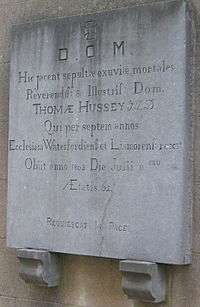Thomas Hussey (bishop)
Bishop Thomas Hussey (1746 – 11 July 1803) was a diplomat, chaplain and Bishop of the Roman Catholic Diocese of Waterford and Lismore from 1797 until his death in 1803. He is best known for taking part in talks with Richard Cumberland in a failed attempt to agree a peace treaty between Spain and Britain during the American War of Independence.
Early life
Hussey was born at Ballybogan, County Meath in 1746. Due to the restrictions of the Penal Laws, Hussey went to the Irish College at Salamanca for his religious training, and joined the Trappists upon completion of his studies.
Diplomatic career
The Pope ordered Hussey to take orders and take a position in the court of the king of Spain. In around 1767 he was appointed as chaplain to the Spanish embassy in London.
Dr. Hussey became Spain's diplomatic contact with England when the Spanish ambassador left London because Spain took sides against England during the American War of Independence. Following discussions with the government of Lord North, Hussey was sent to Madrid to discuss Spain's withdrawal from the American cause. Upon his return to Madrid, he attracted the notice of English Catholics in exile, who appealed to the Pope to involve Hussey in the advancement of the Catholic cause in Ireland.
He befriended the Irish born politician Edmund Burke while in London. Dr. Hussey was elected a Fellow of the Royal Society in 1792.[1]
Maynooth and Waterford
When he returned to Ireland, Hussey played a role in the establishment of Maynooth College, and became its first president in 1795. Shortly thereafter he became the Bishop of the Diocese of Waterford and Lismore. He attracted widespread attention in 1797 by issuing a pastoral letter to his clergy, strongly resenting Government interference in ecclesiastical discipline and the proselytising of Protestants in Ireland through the establishment of religious schools.
Death and burial

Hussey officially opened the first monastery and school of Edmund Ignatius Rice at Mount Sion in Waterford on July 7, 1803. By now in his mid-50s and in poor health, Hussey then settled his estate and had his will drawn up, which amongst other things dealt with the upkeep of Edmund Rice's education of Waterford's poor boys, and ensured the survival of his fledgling religious congregation. After signing the will on July 10, Hussey went on a holiday to nearby Dunmore East. The next morning, he went with Dean Hearn for a swim, but suffered an apoplectic fit and never regained consciousness.
Hussey's remains were brought back to Waterford for burial, but his funeral became the focus of sectarian violence. During the funeral procession to the Great Chapel, the coffin and Hussey's mourners were set upon by a group of drunken soldiers returning from an Orange Order meeting. These men abused the mourners and attempted to throw Bishop Hussey's remains into the River Suir that runs through Waterford. A riot broke out, and the local militia were forced to intervene and recover the remains, which were eventually interred in the Great Chapel as originally intended.[2]
See also
- The Life of Dr. Thomas Hussey 1746-1803, Bishop of Waterford and Lismore, Liam Murphy, Kingdom Books, 2016.
References
- ↑ Dr Thomas Hussey DD FRS (1741-1803)
- ↑ Normoyle, M.C. (1976). A Tree is Planted: The Life and Times of Edmund Rice. Congregation of Christian Brothers. p. 49.
External links
- Entry in the Catholic Encyclopedia
- Hussey's Pastoral Letter to the Diocese of Waterford and Lismore (1797)